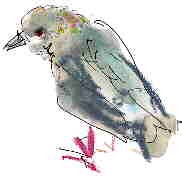Norman
Allan | ||||
| Professor
Savage and the Wild: (1986)
Professor
Savage runs the University of Toronto Faunal Museum. There they keep specimens
of all of Canada's birds and mammals. If I was going to consider adjusting Tara's
spine, I needed to study the anatomy of the canine vertebral column. The Faunal
Museum was the place I could do that, and there I met Dr. Savage. Doc
Savage's main research is the study of animal remains at archeological sites.
Through the examination of specimens he can tell what animals the native people
and settlers were hunting, and domesticating, in the various stages of our history.
Some while ago the Doc dug up a vertebra of a husky from a four thousand year
old site on an arctic island. The vertebra, from the thoraco-lumbar junction,
that's where the ribs end and the low back begins, round the waist, showed osteoarthritic
changes and Professor Savage speculated that the changes were due to the dog working
in harness pulling a sledge. "Nonsense", said a group of straight-laced
scientists when Savage presented his theory. "How can you generalize from
one specimen?" So the Professor analyzed the spines of three working dogs
and three non-working dogs from the same breeding community, and sure enough it
checked out. The working dogs all showed hypertrophic osteophytic degenerative
changes in their thoraco-lumbar regions. The "controls" did not. Now
that's interesting in a general sense for it demonstrates that if you suffer a
lot of physical stress your spine is going to show osteoarthritic changes. But
I guess we knew that. What we didn't know at all was that Eskimo's have been harnessing
dogs for more than four thousand years: So
I spent a while examining the vertebral column of a husky, and decided that spinal
adjustment wasn't the most appropriate therapy for Tara; though I did learn from
that study that when one adjusts or mobilizes dogs it should be done in flexion
rather than extension. But then, while I was there. Dr. Savage showed me some
of his prize specimens, and these were fascinating, and it is one of these that
I wanted to tell you of. Doctor
Savage showed me the rib of a whale, not far off the size and shape of a boomerang.
It was smooth and weathered as though it had spent a good while brushed by the
sea, and it had great tumourus bony overgrowth. It was found on a thousand year
old arctic site, and it has been carbon dated as one thousand years old. Something
felt odd about this specimen to Dr. Savage when he was given it along with this
information, for, says the doctor he has never seen a cancerous growth in the
bones of wild animals! Domestic animals, yes. Pets too. But not in the wild. Not
yet. No doubt they are begin to be seen as pollution spreads into the wilderness,
but as of this writing, there is not yet an industrial haze at the North Pole.
So far Professor Savage hadn't seen bone cancer in the wild, so he was suspicious
when presented with a purportedly thousand year old cancerous whale bone. Being
a man who pursues his suspicions (I guess it is this that makes Ninety years ago someone shot the whale, but didn't kill it. It grew a bony tumor, not as a cancer, but to seal off the poisonous heavy metals of the bullet. When it died its bones weathered on shore, someone picked up the rib, and threw it onto a thousand year old midden where it would confound later day archeologists. But not Doc Savage, who thought to look deeper. There are, of course, morals and messages. The one I want to wave is the link between "technology" and cancer. Artificial foods, artificial chemicals, artificial stress are deadly. Remember this when considering the fruits of civilization. Remember Dr. Savage and the wild. |
|  |